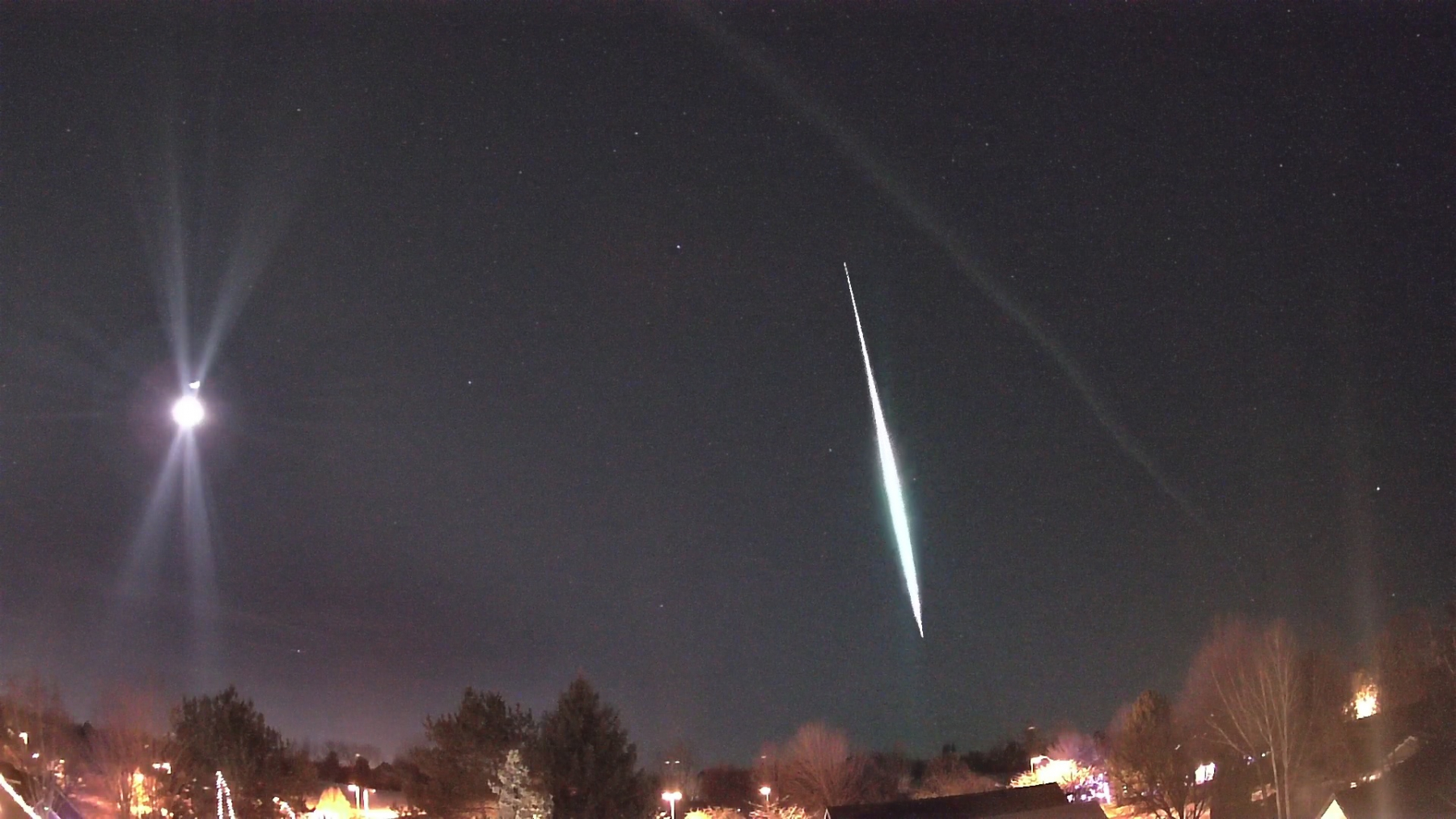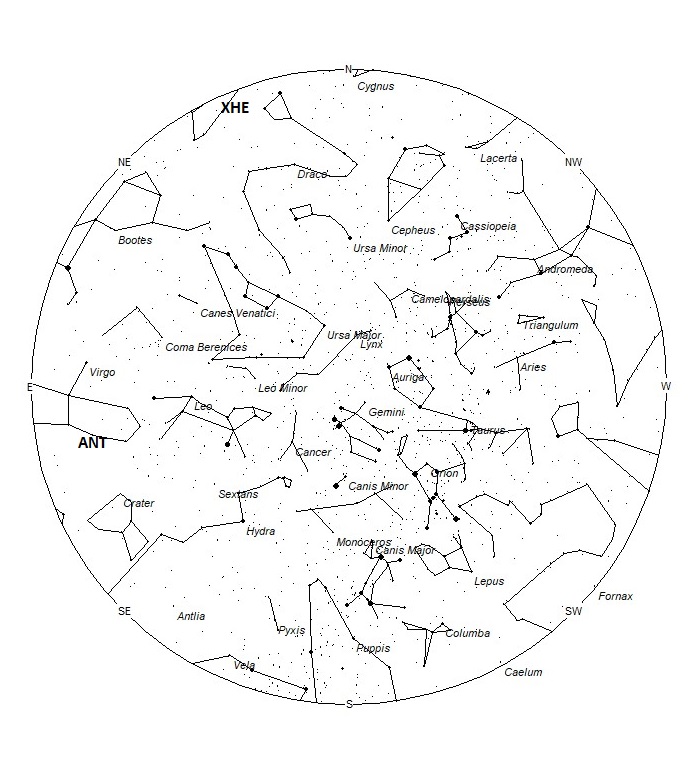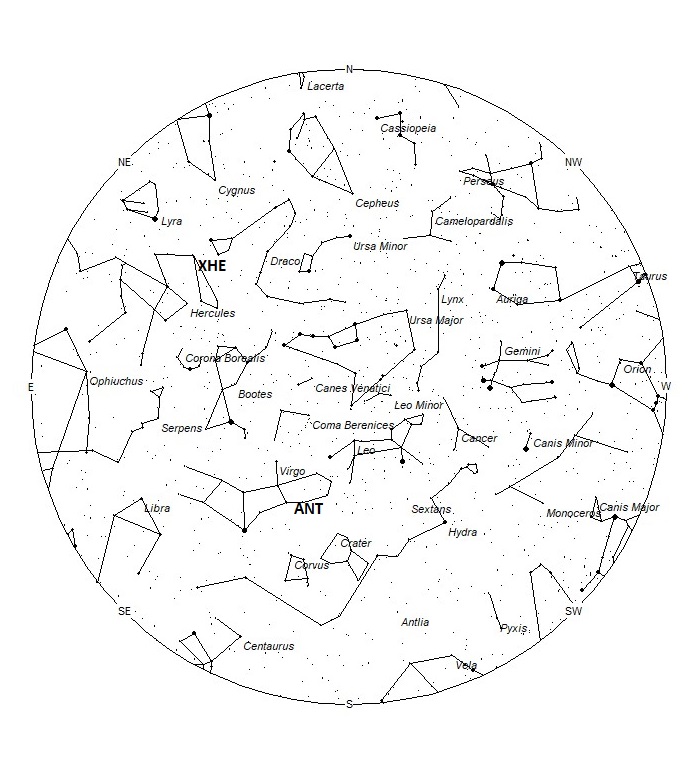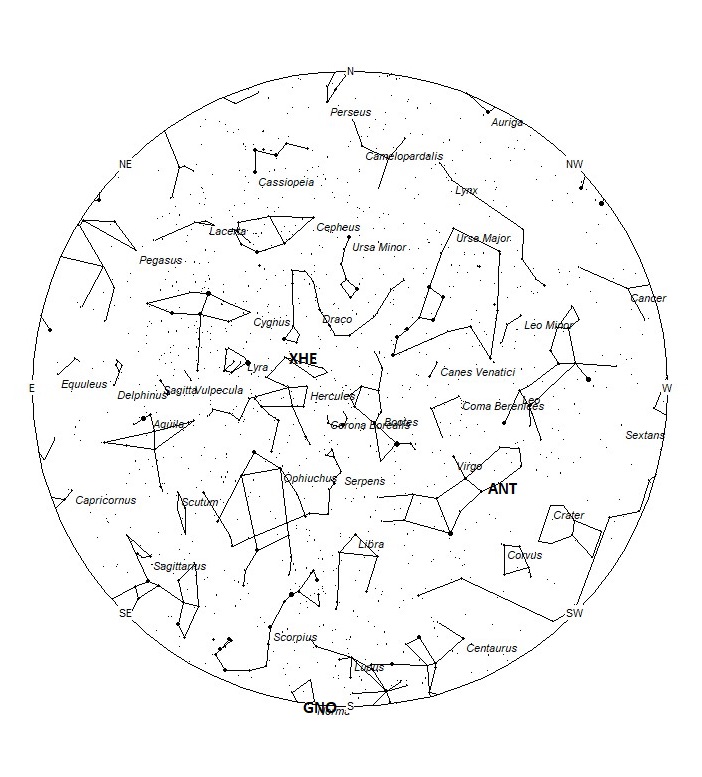 Jordan Ragsdale captured this brilliant fireball using his AllSky Camera System on January 8, 2022 at 20:39 MST (03:39 UT on Jan 9) from Eagle, Idaho, USA. ©Jordan Ragsdale
Jordan Ragsdale captured this brilliant fireball using his AllSky Camera System on January 8, 2022 at 20:39 MST (03:39 UT on Jan 9) from Eagle, Idaho, USA. ©Jordan RagsdaleDuring this period, the moon reaches its full phase on Friday March 18th. At that time the moon lies opposite the sun in the sky and lies above the horizon all night long. This weekend the waxing gibbous moon will set during the early morning hours but will not interfere with meteor observing during the more active morning hours, allowing a few hours of dark sky observing prior to dawn. For evening observers, the estimated total hourly rates should be near 2 as seen from mid-northern latitudes (45N) and 3 as seen from tropical southern locations (25S) For morning observers, the estimated total hourly rates should be near 7 as seen from mid-northern latitudes (45N) and 12 as seen from tropical southern locations (25S). The actual rates will also depend on factors such as personal light and motion perception, local weather conditions, alertness, and experience in watching meteor activity. Evening rates are reduced due to moonlight. Note that the hourly rates listed below are estimates as viewed from dark sky sites away from urban light sources. Observers viewing from urban areas will see less activity as only the brighter meteors will be visible from such locations.
The radiant (the area of the sky where meteors appear to shoot from) positions and rates listed below are exact for Saturday night/Sunday morning March 12/13. These positions do not change greatly day to day so the listed coordinates may be used during this entire period. Most star atlases (available at science stores and planetariums) will provide maps with grid lines of the celestial coordinates so that you may find out exactly where these positions are located in the sky. I have also included charts of the sky that display the radiant positions for evening, midnight, and morning. The center of each chart is the sky directly overhead at the appropriate hour. These charts are oriented for facing south but can be used for any direction by rotating the charts to the desired direction. A planisphere or computer planetarium program is also useful in showing the sky at any time of night on any date of the year. Activity from each radiant is best seen when it is positioned highest in the sky, either due north or south along the meridian, depending on your latitude. It must be remembered that meteor activity is rarely seen at the radiant position. Rather they shoot outwards from the radiant, so it is best to center your field of view so that the radiant lies at the edge and not the center. Viewing there will allow you to easily trace the path of each meteor back to the radiant (if it is a shower member) or in another direction if it is sporadic. Meteor activity is not seen from radiants that are located far below the horizon. The positions below are listed in a west to east manner in order of right ascension (celestial longitude). The positions listed first are located further west therefore are accessible earlier in the night while those listed further down the list rise later in the night.
These sources of meteoric activity are expected to be active this week.
The delta Mensids (DME) are active from March 13-25, with maximum occurring March 18-22. This is normally a very weak shower with rates near 1 shower member per night. Recently though, a spike of activity has occurred between March 20-22. A report of recent activity from this radiant on March 12 was actually from the nearby beta Tucanid radiant. At maximum, the radiant is located near 03:52 (058) -80. This area of the sky is located in western Mensa, 6 degrees south of the 3rd magnitude star known as gamma Hydri. These meteors are best seen as soon as it becomes dark in the deep Southern Hemisphere. They are not visible from the Northern Hemisphere. With an entry velocity of 33 km/sec., these meteors would be of slow velocity.
The beta Tucanids (BTU) produced an outburst last year on 12 March. This was unexpected as activity of around one per night is more common for this display. If the outburst re-occurs again in 2022, it should occur on a 20-hour time frame centered on 6:00 Universal Time on 13 March. Early members of this shower may appear as early as 2 March, but rates would be extremely low. On the night of 12 March, the radiant is located at 04:07 (062) -77. The current location should not be much different due to the high southern declination. This area of the sky is located in western Mensa, two degrees southeast of the 3rd magnitude star known as gamma Hydri. These meteors are best seen as soon as it becomes dark in the deep Southern Hemisphere. They are not visible from the Northern Hemisphere. With an entry velocity of 31 km/sec., these meteors would be of slow velocity. Don’t confuse these meteors with the delta Mensids, which become active a bit later in March and peak near 20 March.
The large Anthelion (ANT) is currently centered at 12:20 (185) -02. This position lies in western Virgo, 1 degree south of the 4th magnitude star known as Zaniah (eta Virginis). Due to the large size of this radiant, these meteors may also be seen from eastern Leo as well as western Virgo. This radiant is best placed near 02:00 local Daylight Saving time (LDST) when it lies on the meridian and is highest in the sky. Rates at this time should be near 2 per hour no matter your location. With an entry velocity of 30 km/sec., the average Anthelion meteor would be of slow velocity.
The gamma Normids (GNO) are an ill-defined source, only well seen from the Southern Hemisphere. Some sources dispute its existence while others have differing activity periods in March. Here we list the parameters from the International Meteor Organization*. They believe the activity period is from February 25 through March 28, with maximum activity occurring on March 14. At maximum, the radiant is located at 15:56 (239) -50. This area of the sky lies in central Norma, 1 degree southwest of the faint star known as eta Normae. These meteors are best seen during the last dark hour before dawn, when the radiant lies highest in a dark sky. With an entry velocity of 56km/sec., the average meteor from this source would be of medium-fast velocity. Zenith hourly rates are listed as 6 at maximum, but I believe this is overly optimistic.
The xi Herculids (XHE) were discovered by Sirko Molau and Javor Kac in 2009, using data from the IMO Video Network. These meteors are active from March 6-20, with maximum activity occurring on March 12th. Rates are low during the entire activity period, never surpassing 1 per hour. The radiant is currently located at 17:04 (256) +48. This position lies in extreme northern Hercules, 5 degrees southwest of the 3rd magnitude star known as Rastaban (beta Draconis. These meteors are not well seen from the Southern Hemisphere due to the high northern location of the radiant. These meteors are best seen during the last dark hour before dawn, when the radiant lies highest in a dark sky. With an entry velocity of 35km/sec., the average meteor from this source would be of medium velocity.
The delta Pavonids (DPA) were discovered by Michael Buhagiar from Australia in the 1970’s. These meteors are active from March 11 through April 16, with maximum activity occurring on March 30th. The current position of the radiant lies near 18:37 (279) -59. This area of the sky lies in northwestern Pavo, 3 degrees southwest of the faint star known as xi Pavonis. These meteors are best seen during the last dark hour prior to dawn. With an entry velocity of 58km/sec., the average meteor from this source would be of fast velocity. Expected rates are less than 1 per hour during this period. Like the gamma Normids, these meteors are poorly seen from the Northern Hemisphere.
As seen from the mid-northern hemisphere (45N) one would expect to see approximately 5 sporadic meteors per hour during the last hour before dawn as seen from rural observing sites. Evening rates would be near 1 per hour. As seen from the tropical southern latitudes (25S), morning rates would be near 10 per hour as seen from rural observing sites and 2 per hour during the evening hours. Locations between these two extremes would see activity between the listed figures. During this period evening rates are reduced due to moonlight.
You can keep track of the activity of these meteor showers as well as those beyond the limits of visual observing by visiting the NASA Meteor Shower Portal available at: https://meteorshowers.seti.org/ You can move the sky globe to see different areas of the sky. Colored dots indicate shower meteors while white dots indicate sporadic (random) activity. The large orange disk indicates the position of the sun so little activity will be seen in that area of the sky.
| SHOWER | DATE OF MAXIMUM ACTIVITY | CELESTIAL POSITION | ENTRY VELOCITY | CULMINATION | HOURLY RATE | CLASS |
| RA (RA in Deg.) DEC | Km/Sec | Local Daylight Saving Time | North-South | |||
| delta Mensids (DME) | Mar 20 | 03:52 (058) -80 | 33 | 18:00 | <1 – <1 | III |
| beta Tucanids (BTU) | Mar 13 | 04:07 (062) -77 | 31 | 18:00 | <1 – <1 | III |
| Anthelions (ANT) | — | 12:20 (185) -02 | 30 | 02:00 | 2 – 2 | II |
| Gamma Normids (GNO) | Mar 14 | 15:56 (239) -50 | 56 | 06:00 | <1 – <1 | IV |
| xi Herculids (XHE) | Mar 12 | 17:04 (256) +48 | 35 | 07:00 | <1 – <1 | IV |
| Delta Pavonids (DPV) | Mar 31 | 18:37 (279) -59 | 58 | 09:00 | <1 – <1 | III |
 American Meteor Society
American Meteor Society



Moments ago I was sitting on my parents’ porch, facing westward. I just saw a burning meteor down on its way to hit the earth’s surface. I could visibly see the fire as it got closer. At first i thought it was a huge shooting star but it kept coming down and getting closer to horizon. About a minute or less later I heard something that sounded like faint baby thunder.
I just googled “meteor march 14 midwest” and found your page. I wanted to share what I saw with someone. I live in Cincinnati, Ohio.
I live in Central Illinois half way between Springfield and St. Louis, MO. Tonight (3/16/22) at about 9:32 p.m. I spotted what looked like a shooting star in the northern sky. It was a bright streak that lastedd only a few seconds. Did anyone else spot it?
Yes my daughter saw and got a pic while she was in Paris France it was only there for a few seconds. And another person saw it in Chesterfield Virginia. She saw it march 15 but Paris is 7 it 8 hours ahead of est. Then on same day a discovery was made at Notre Dame. Found a tomb over 700 yrs old. Had a body still.
i was in my room when at about 12:40 am i see through my window blind a bright shooting star when i look closer it was on fire and it kept coming down and it just looked like a rock coming down to the earths atmosphere